Purpose of Schedule / Memorandum supporting document
The primary purpose of the Schedule / Memorandum supporting document is to record the information about easements required by rules 93 and 94 of the CSR 2021 and section 243(b) of the Resource Management Act 1991 (RMA). This information must be in tabular form (r93(2) & r94(2)).
Rule 93 CSR 2021
Rule 94 CSR 2021
Section 243 RMA
A Schedule / Memorandum may also be used to record covenant notations required by rule 95, details of any easement to be surrendered or covenant to be revoked as required by rule 92(h), and amalgamation conditions imposed under section 220(1)(b) RMA.
Memorandum of easements
Where a territorial authority (TA) imposes a condition in a subdivision consent requiring the creation of easements, these compulsory easements must be recorded in a table with the heading “Memorandum of Easements”, as shown in the example below, or “Memorandum of Easements in Gross” (see Easements in gross below)
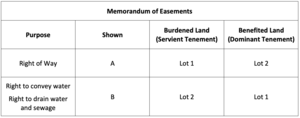
Figure 1: Example of Memorandum of Easements
A memorandum only applies to new easements being created. When an existing easement is to be retained, it must be recorded in a table with the heading “Schedule of Existing Easements” even if it was originally recorded in a memorandum (r 94(2)(a)).
If a memorandum is included in a CSD, the section 223 RMA certificate must refer to the approval being subject to the granting or reserving of the easements set out in the memorandum.
Once created, if a compulsory easement is varied or surrendered, the TA will need to provide a certificate that the condition requiring the easement has been cancelled in whole or in part. A section 243(e) RMA certificate for this purpose can be prepared using the TA Certification functionality in Landonline for approval by the TA.
Schedule of easements
Where a new easement is not required by the TA, it must be recorded in a table with the heading “Schedule of Easements”, as shown in the example below, or “Schedule of Easements in Gross” (see Easements in gross below).

Figure 2: Example of Schedule of Easements on Landonline
Easements in gross
An easement in gross is for the benefit of a certain person or entity (the grantee), rather than a specific piece of land. An easement in gross may be recorded in a separate table with the heading “Memorandum of Easement in Gross”, “Schedule of Easements in Gross” or “Schedule of Existing Easements in Gross”, as shown in the examples below. Note that a column with the heading of Grantee is required instead of Benefited Land.
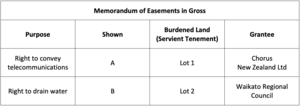
Figure 3: Example of Memorandum of Easements in Gross
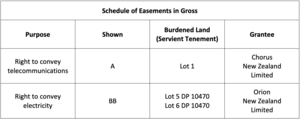
Figure 4: Example of Schedule of Easements in Gross
Accounting for existing easements
All existing subject easements need to be accounted for on the title plan, whether they are to be retained or surrendered, or partially surrendered.
Easements to be retained must be in a tabular form under the heading “Schedule of Existing Easements” (r 94). Where the easements to be retained are easements in gross, it is acceptable for the heading “Schedule of Existing Easements in Gross” to be used.
Where an easement is not defined in an approved CSD the Schedule of Existing Easements must still include the purpose of the easement, creating document reference and burdened land. As the easement is not spatially defined, the easement parcel identifier should refer to the new primary parcel appellation that the easement relates to.
Example schedules are shown below.
The easement purpose must use the exact wording used in the creating document. Refer to Easement purpose below.
The first table includes a right to drain sewage created by a pipeline certificate that was not defined on an approved CSD.
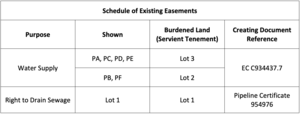
Figure 5: Example of Schedule of Existing Easements
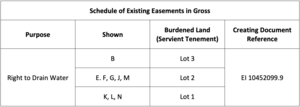
Figure 6: Example of Schedule of Easements in Gross
Details of easements to be wholly or partially surrendered must be included in the title plan (r92(h). They may be presented in tabular form, with the Landonline Automated Schedule / Memorandum supporting this, or they can be included by way of adding a note to the schedule. The CSR 2021 require the creating document reference to be included. See Figure 7 below.
Where there is a partial surrender as a result of a road to vest or legalisation action, the portion being surrendered does not need to be identified in the CSD.
While the intentions for dealing with existing easements should be included in the survey report, it does not form part of the title plan and therefore does not satisfy the requirements of rules 92(h) and 94.
Content of a CSD – How CSD components fit together in Landonline
Note that the correct term is to surrender the easement, as set out by sections 108 & 109 of the Land Transfer Act 2017 (LTA). Removing and extinguishing easements have a separate legal meaning and refer to different processes under s113 – 115 LTA. Therefore, it is important to refer to the correct terminology.
Where an existing compulsory easement is to be surrendered, the TA will need to provide a certificate that the condition requiring the easement has been cancelled. A section 243(e) RMA certificate for this purpose can be prepared using the TA Certification functionality in Landonline for approval by the TA.
Refer to:
- Capture and depiction – Supporting documents
- Non-primary parcels – Surrendering part of an easement or revoking part of a covenant
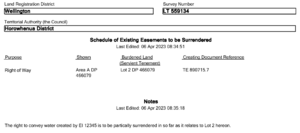
Figure 7: Surrender of an easement using Landonline easement schedule functionality
Appurtenant easements
The record of title shows details of subject and appurtenant easements under the Interests section, as shown in Figure 8 below. Subject easements are over land contained in the record of title. Appurtenant easements are over other land for the benefit of the land contained in the record of title.

Figure 8: Example of Interests on a Record of Title
Existing appurtenant easements are required to be accounted for on Unit Title plans, in the same way as subject easements (r94(1)). It is not necessary to include them in CSDs for other survey purposes. An example of a schedule of existing appurtenant easements for a unit title development is shown below.
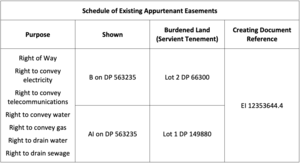
Figure 9: Example of Schedule of Existing Appurtenant Easements
Unit plans - CSD requirements for easements and covenants on unit plans
Easement purpose
The purpose used for an existing easement must be the exact wording used in the creating document.
The rights and powers implied in certain easements are set out in Schedule 5 of the Land Transfer Regulations 2018. Where a new easement being created is intended to rely on these rights and powers, the purpose of the easement shown in the Schedule / Memorandum must be the same as one or more of the classes of easement in Schedule 5:
- right to convey water
- right to drain water
- right to drain sewage
- right of way
- right to convey electricity
- right to convey telecommunications
- right to convey gas.
Other easement purposes may be used, but a solicitor should be consulted to confirm the wording and that an easement can be granted for the intended purpose.
Parcel identifiers
Where an existing easement is being retained, the appellation for the new non-primary parcel must be in terms of the new CSD (r 42(1)). This applies whether the easement parcel remains unchanged or is severed (where it overlaps with new underlying estates).
Where an existing easement to be retained has not been defined in an approved CSD, the easement must still be included in a schedule of existing easements. The easement parcel identifier should be the same as the appellation of the burdened land. See the pipeline certificate example in Schedule of Existing Easements table above – Figure 5.
For easements to be surrendered or appurtenant easements in the case of unit plans, the unique parcel identifier from the most recently defined area, along with the CSD number referred to, should be used.
Burdened land (Servient Tenement)
The burdened land or servient tenement is the land over which the easement is registered. The appellation of the underlying parcel should be used for the description of the burdened land in the table.
The LTA modernised the term from servient tenement to burdened land. Servient tenement is still referred to in the RMA, therefore both terms should be included in the table heading.
For easements to be surrendered, the parcel appellation should refer to the burdened land from the most up to date reference. It does not have to be in terms of the new CSD.
Benefited Land (Dominant Tenement)
The benefited land or dominant tenement is the land that takes the benefit of the easement.
The LTA modernised the term from dominant tenement to benefited land. Dominant tenement is still referred to in the RMA, therefore both terms should be included in the table heading.
Creating Document Reference
The creating document reference should be the instrument number of the document that created the easement right. It should not be the document that varies the easement. The reference may include the instrument type abbreviation, however it is the instrument number that is most important.
Covenants
Land covenants to be revoked must be included in the title plan (r92(h)). It is not sufficient to only record this information in the survey report. It is recommended that this information is included in the Schedule / Memorandum along with any notations required by rule 95 for new covenants and existing covenants defined on an approved CSD to be retained. The creating document reference for any existing covenant to be revoked or retained must be included in the notation. An example of a covenant notation is shown below.

Figure 10: An example of a Land Covenant note
Amalgamation conditions
Section 241(1) RMA requires amalgamation conditions imposed on a subdivision consent under section 220(1)(b) RMA to be included in the CSD of the subdivision. One way of satisfying this requirement is to include the amalgamation conditions in the title plan. If they are included in the title plan, it is recommended they should be noted on the Schedule / Memorandum rather than the title diagram. It is easier to change a supporting document than the title diagram should a change need to be made.
The amalgamation condition notation should also include the LINZ request number.
Landonline Automated Schedule / Memorandum
The Landonline automated Schedule / Memorandum provides functionality to record the required tables and includes free text notes. Surveyors are encouraged to use this functionality, as it:
- has the appropriate table headers
- pulls through the creating document number from the record of title (no transposing numbers)
- automatically identifies the burdened land
- makes the cancellation process more efficient.
In the automated Schedule / Memorandum, users can enter free text into the following 3 fields:
- Purpose - a user can add their own purpose in the first field if the drop-down list doesn't cater for what they need. NOTE when free text is entered here, the other Purpose field becomes inactive.
- Shown - free text can be added here if the existing appellation required is not spatially captured in Landonline.
- Grantee - free text field.
Errors with schedules/memorandum are consistently one of the top requisition items. Many requisitions are due to simple errors like transposing document numbers, having the benefited/burdened land around the wrong way, and wrong column headings. Therefore, many requisitions may be avoided by using this functionality.
As Landonline is modernised, work completed by surveyors and solicitors/conveyancers will be more connected. Using the functionality in Landonline will enable efficient transition between the processes.
Schedule / memorandum (New Landonline)
Find templates for creating easement tables manually:
Height-Limited Areas
When a height-limited area is created, all rights associated with that area are constrained to this limit. Some surveyors show height limited detail within the Schedule / Memorandum of easements; however, this needs to be consistently applied across all references to the height-limited area. The presence of a height limit on one right but not for the same area reference for a different purpose creates ambiguity as the parcel area does not appear contiguous.
While upper and lower limits can be recorded in a Schedule / Memorandum of easements, this alone will not satisfy rule 97(1)(a) as the schedule does not form part of the title diagram. If they are shown in the Schedule / Memorandum, check they are consistent with those shown on the title diagram.
Examples of Land Transfer Plans with height-limited easements
Refer to:
Approved CSD amendment
Should a change to the memorandum/schedule be required after CSD approval but prior to deposit, the supporting document may be able to be replaced. A request in Landonline can be made using the request type ‘Survey - Approved CSD Correction / Amendment’.
If the change involves a memorandum, a letter or email from the TA that they approve the changes and signed by the appropriate officer is required. This includes amalgamation condition wording.
Refer also: